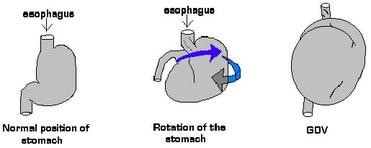Bloat
by Sandra Wickwire, DVM
The thought of “bloat” should strike fear in any large breed dog owner. Medically referred to as gastric dilatation-volvulus (GDV), this is a life-threatening disorder which requires emergency medical and surgical care. Early recognition and treatment are essential. Gastric dilatation refers to distention of the stomach with gas, usually swallowed air. Volvulus, which may or may not be present, is where the stomach rotates on its long axis. This results in complete obstruction of outflow of stomach contents, including gas. Severe distention of the stomach will impinge on the blood flow of major blood vessels in this area. Loss of blood flow to the stomach and spleen quickly leads to necrosis (tissue death) of these organs. Hypovolemic and endotoxic shock, which follows rapidly, will lead to death if not treated.

Unfortunately the cause(s) of GDV is yet unknown. One known factor is the anatomic body type that is affected: large-breed, deep-chested dogs. It also usually occurs in middle-aged to older dogs. Swallowing excessive amounts of air (as with gulping food, difficulty breathing, or pain) or delayed emptying of the stomach may play a role. Overeating, exercise after eating, or a dry or cereal-based diet have all been suggested contributors but not proven. One study of 101 dogs with GDV showed an increased incidence in males, being underweight, eating one meal a day, eating rapidly, and having a fearful temperament. Dogs at a decreased risk were those with a “happy” temperament that received table scraps in addition to their diet of dry dog food. Stress was the only common factor that appeared to precipitate an episode of GDV.
Warning Signs
- Sudden onset of abdominal distention, i.e., looks “bloated”
- Non-productive retching (trying to vomit but doesn’t)
- Increased salivation, restlessness, respiratory distress
- Depression, weakness, staggering
- Discolored (pale or brick red) mucus membranes (gums)
What do I do?
Don’t panic – your dog needs you to function! Think of where the closest accessible veterinary facility is. If after hours, is there an emergency clinic in your area (information to know ahead of time)? Go!!!
Decompressing (letting the air out of) the stomach may buy some time IF you have the equipment and expertise, or at least good instructions and understanding. To pass a stomach tube, first measure the correct length by laying the tube along the side of the dogs neck. Align the rounded edge at the end of the dogs rib cage then mark the tube (a piece of white tape works well) where it would reach the opening of the dogs mouth. Use a roll of white medical tape (large enough not to swallow) placed sideways in the mouth (so you can see into the mouth through the hole) to hold the jaws open. After lubricating the stomach tube pass it through the tape roll and gently attempt to pass it down to the previously marked point. Do NOT use force, as this may lead to perforating the esophagus. In some cases, it is not possible to pass a tube if the stomach is twisted as to block the opening.
What to Expect at the Vet
The veterinarian initially will treat for shock (IV fluids and steroid injection) and stabilize the dog’s general condition. They will then attempt to decompress the stomach by tubing, or if unable they may use a large gauge needle to trocarize (puncture through the body wall) the stomach. Preventive antibiotics may be administered. If available, an ECG will be used to monitor for secondary cardiac arrhythmias. X-rays will be taken to confirm the diagnosis and evaluate the position of the stomach. If the stomach is twisted, surgery is required to reposition and preferably suture it into place. Suturing the stomach in place will decrease the recurrence rate to 3-5% as opposed to 70-80%. Prognosis is based on surgical assessment of tissue damage and on postoperative recovery status.
Prevention
Since the exact reasons for bloat are uncertain effective preventive measures are also uncertain. Some suggestions include:
Feed small frequent meals, 3-5 times a day
Reduce the speed of eating (feed smaller amounts or place a large object in the bowel with the food)
Limit water intake, i.e., do not let dog consume large quantities at once, and do not allow water until one hour after eating.
Immediate recognition and treatment
Websites to check out
- http://www.ualberta.ca/~dc8/szbloat.htm
- http://www.cheta.net/connect/canine/Archives/bloat.htm
- http://nbb.emory.edu/saint/Bloat_Purdue
- http://www.sai.com/orgs/nhdrl/bloat.html
- http://www.ddc.com/rescue/dane/bloat.htm
References
- Saunders Manual of Small Animal Practice, Birchard & Sherding, 1994, pp 674-675
- The 5 Minute Veterinary Consult, Tilley & Smith, 1997, pp608-609
- “Predisposing Factors in GDV”, Glickman, JAAHA May/June 1997
This information is provided for educational purposes only and is not a substitute for medical advice. It is not to be used for diagnosing or treating a health problem, nor is it a substitute for professional care. If you suspect that your dog may have a health problem, please consult your veterinarian.
